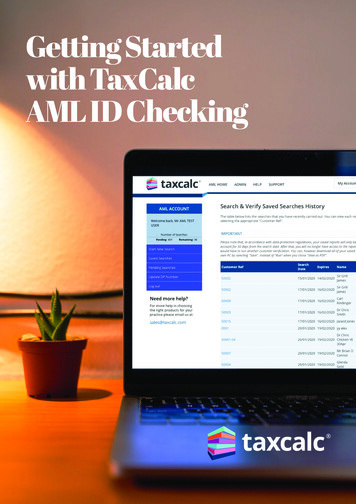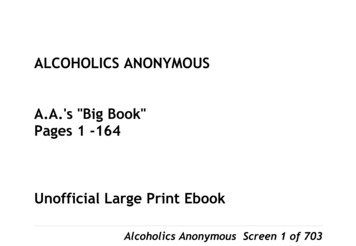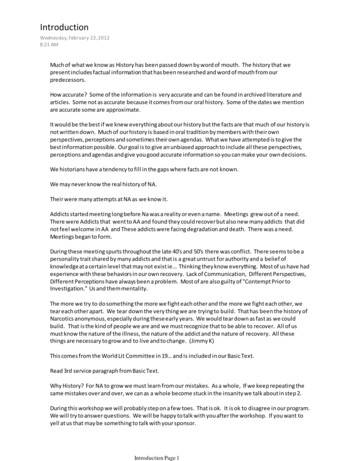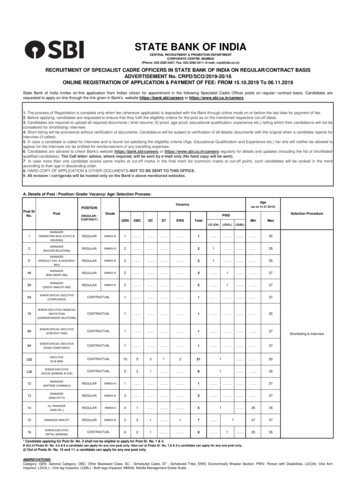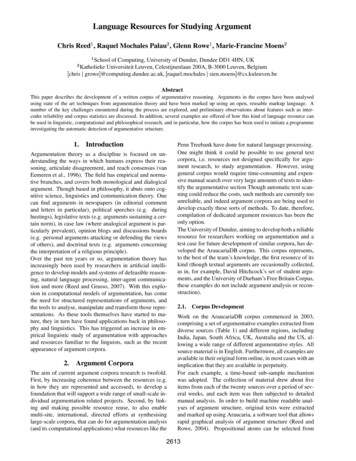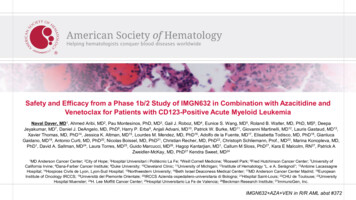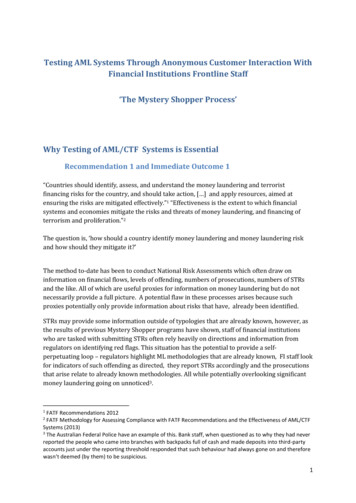
Transcription
Testing AML Systems Through Anonymous Customer Interaction WithFinancial Institutions Frontline Staff‘The Mystery Shopper Process’Why Testing of AML/CTF Systems is EssentialRecommendation 1 and Immediate Outcome 1“Countries should identify, assess, and understand the money laundering and terroristfinancing risks for the country, and should take action, [ ] and apply resources, aimed atensuring the risks are mitigated effectively.”1 “Effectiveness is the extent to which financialsystems and economies mitigate the risks and threats of money laundering, and financing ofterrorism and proliferation.”2The question is, ‘how should a country identify money laundering and money laundering riskand how should they mitigate it?’The method to-date has been to conduct National Risk Assessments which often draw oninformation on financial flows, levels of offending, numbers of prosecutions, numbers of STRsand the like. All of which are useful proxies for information on money laundering but do notnecessarily provide a full picture. A potential flaw in these processes arises because suchproxies potentially only provide information about risks that have, already been identified.STRs may provide some information outside of typologies that are already known, however, asthe results of previous Mystery Shopper programs have shown, staff of financial institutionswho are tasked with submitting STRs often rely heavily on directions and information fromregulators on identifying red flags. This situation has the potential to provide a selfperpetuating loop – regulators highlight ML methodologies that are already known, FI staff lookfor indicators of such offending as directed, they report STRs accordingly and the prosecutionsthat arise relate to already known methodologies. All while potentially overlooking significantmoney laundering going on unnoticed3.1FATF Recommendations 2012FATF Methodology for Assessing Compliance with FATF Recommendations and the Effectiveness of AML/CTFSystems (2013)3The Australian Federal Police have an example of this. Bank staff, when questioned as to why they had neverreported the people who came into branches with backpacks full of cash and made deposits into third-partyaccounts just under the reporting threshold responded that such behaviour had always gone on and thereforewasn’t deemed (by them) to be suspicious.21
A significant problem arises, as has been the case in some jurisdictions, when those tasked withsubmitting STRs are the same people conducting the laundering.A National Risk Assessment perhaps should include information on say, the level ofeffectiveness of training of frontline financial institution staff, or, the willingness of financialinstitutions and DNFBPs to reject potentially profitable business involving illicit funds, or, thewillingness of financial institutions to engage in and assist their customers to engage in moneylaundering. It perhaps also should include information on the effectiveness of border currencysearching capacity, or the capacity and willingness of casinos to detect and report (or reject andreport) suspicious activity.In fact, ideally a National Risk Assessment perhaps should be informed by a range of statisticsand information on all aspects of the AML/CTF system and how well they are functioning. Fromthe effectiveness of financial institution staff in identifying and responding to suspiciousactivities to the ease or difficulty with which smurfing might be conducted to the ease ordifficulty with which an anonymous company or structure might be able to gain access to abank account.A national AML system that is passive, that doesn’t test the systems and processes foreffectiveness , or actively seek to identify money laundering and terrorist financing and themethodologies through which they occur, may possibly only ever be partially effective .One method for addressing these deficiencies is active testing of AML/CTF systems through aMystery Shopper process.Other Recommendations Relevant to Mystery Shopper TestingTwo other Recommendations may be viewed as supporting AML/CTF systems testing, these areRecommendation 26 and 28. Recommendation 26 on Regulation and supervision of financialinstitutions requires countries to ensure that financial institutions are subject to adequateregulation and supervision and are effectively implementing the FATFRecommendations. At a minimum, where financial institutions provide a service of money orvalue transfer, or of money or currency changing, they should be licensed or registered, andsubject to effective systems for monitoring and ensuring compliance with national AML/CFTrequirements.Similarly, Recommendation 28 on Regulation and Supervision of DNFBPs requires countries toensure that competent authorities ensure that casinos are effectively supervised for compliancewith AML/CFT requirements and that other DNFBPs are subject to effective systems formonitoring and ensuring compliance with AML/CFT requirements.It is arguable that there may be no better means of ‘monitoring and ensuring compliance’ thanthrough active testing.Mystery Shopper Methodology - from Other SituationsThe concept of a ‘mystery shopper’ comes from the assessment of customer service in shops bya person, who is unknown to the shop staff being assessed. The Mystery Shopper visits the shopand purchases an item as a normal customer would. The Mystery Shopper then records the2
good and bad points from their shopping experience and the data is used to make anassessment of the business or the staff.Such methodology has been used to compare businesses in a town or region for businessawards. Other uses of such a process is to enable management to gather information oncustomer experience, staff training, staff morale and the like in order to allow improvements tobe made.Methods of Testing of Systems in Other SituationsIn today’s age of cyber-terrorism it would be highly unlikely for a national agency or largecompany to deploy an information and communication technology (ICT) system or softwarethat had not been tested against hacking, exploitation or systems faults. Ironically, however,many countries and jurisdictions around the world currently have in place AML systems thathave been developed and deployed and rely entirely on the assumption that they are fit forpurpose and remain almost completely untested.Like AML systems, ICT systems are vulnerable to harmful exploitation. Also like an ICT system,those doing the exploitation rarely announce their success. They attempt to operate in secret,cover their tracks and utilise vulnerabilities that are unknown to those who have set up thesystem.For many years governments and system software providers have made (or engaged others) tomake deliberate attempts to infiltrate and hack systems or software. Such testing provides vitaldata on weaknesses and allows for corrective action, or patches to be implemented.The Mystery Shopper process is analogous to the attempted exploitation, circumvention or‘hacking’, of a country’s AML systems in order to provide intelligence on weaknesses and allowfor corrective action to be implemented.Identifying Implicit Assumptions Contained in AML/CTF Systems.Implicit in many jurisdiction’s AML/CTF systems is the assumption that gatekeepers will be proactivein preventing offending by their customers.Also implicit in the assumptions is the belief that law enforcement will be capable of dealing with thenumbers of STRs reported and that prosecutions for money laundering and related AML/CTFoffences will occur in sufficient volumes to provide a deterrent both to individual launderers,syndicates, gatekeepers, facilitators, financial institutions and DNFBPs.Numerous Mutual Evaluation Reports have shown that for many, if not most, jurisdictionsprosecutions for money laundering are low in comparison to the levels of predicate offendingthereby providing little in the way of deterrent for launderers of all types.3
Prosecutions, or punitive action, for other AML/CTF related offending such as failing to report STRs,failing to report threshold transaction reports etc are arguably also below levels likely to provide adeterrent in most jurisdictions.Furthermore, the levels of STRs in many jurisdictions are at levels that overwhelm FIUs, regulatorsand law enforcement.For AML/CTF systems predicated on financial institutions and DNFBPs being the gatekeepersidentifying, reporting and preventing laundering, effectiveness unfortunately, relies on thosegatekeepers being willing to not only identify and report ML and TF but also to be proactive interminating otherwise profitable relationships.Experience has shown that this is less likely to occur in jurisdictions where financial institutions andentities have little or no cause to fear detection or prosecution but even in jurisdictions such as theUS, the level (and perhaps type) of punitive action does not appear to be stemming the tide ofoffending.Proxy measures of effectiveness of AML/CTF systems such as the number of STRs reportedcompared to GDP, prosecutions, restraint actions etc, have the potential to be misleading indetermining the effectiveness of a country’s AML/CTF systems. This is because it is all but impossibleto determine whether a large number of prosecutions or restraint action is because there is a lot offinancially motivated crime or whether the authorities are particularly effective in detecting andprosecuting. Similarly, a high volume of STRs may indicate an effective reporting system or hide largenumbers of repeat STRs about the same people4 (indicating a disinclination on the part ofinstitutions to cease business with criminals) or large volumes of defensive or ‘junk’ reporting.A potential example of the difficulties facing regulators lies in the low level of prosecutions for failingto properly train staff to identify and respond to suspicious transactions and events. It may be thatthe difficulty arises from regulators trying to prove that financial institution staff had not beenproperly trained when an institution claims otherwise. Regulators have often been drawn to theexistence of a training program (and less commonly, exam results from staff testing) however thesealone do not prove that staff are adequately trained.Recent years have provided numerous examples of financial institutions that were not only unableto identify or report ML but were willing to engage in, and actively court, business with criminals andthose who wished to circumvent sanctions.The difficulty for regulators is determining which institutions and entities are acting legally andappropriately and which are not. A Mystery Shopper program has the potential to identify thoseinstitutions and allow regulators to focus attention on them.4A bank in Pacific country apparently reported a single individual over 100 times before deciding to terminatethe relationship. The AML regulator in that country apparently never commented or advised – hardly ameasure of an effective system.4
Reliance on private enterprise potentially inappropriateA typical answer to a question such as ‘Who is responsible for detecting money laundering in yourcountry?’ is ‘ banks or other financial institutions’. This reliance, where it occurs, possibly overlooksthe fact that financial institutions are first and foremost profit driven and appear (at least in thesome countries) to be factoring fines for AML deficiencies into the ordinary cost of doing business.If, as appears may be the case, that some financial intuitions would rather pay a fine than go to thetrouble and expense of implementing effective AML systems, the reliance on these institutions todetect ML and FT may be somewhat naïve.A Mystery Shopper process has the potential to actively identify money laundering weaknesses andsupport targeted intelligence collection to identify money laundering or terrorist financing.What Mystery Shopper process does not testThe Mystery Shopper processes do not test ‘risk’. In identifying specific instances of AML failingssuch as, a financial institution failing to report suspicious transactions or failing to conductappropriate customer identification or actively assisting a customer to circumvent AML controls, theMystery Shopper process allows for the collection of information or intelligence on AML systemsweaknesses.The information collected during the Mystery Shopper process may be able to be used to infer therisk of other sections of the AML system having similar failings, such as other financial institutionsacting criminally, however such an inference may need to be supported by additional data.The intention of the Mystery Shopper process is to allow identification of actual AML failings and toallow corrective action to be undertaken.If for example it is identified that financial institution frontline staff were incapable of identifying andresponding to money laundering or terrorist financing it may be determined that the AMLweaknesses arose due to a lack of education, guidance or information. If however the staff werecapable of identifying money laundering but were unwilling to respond in an appropriate way thismay call for an entirely different response. Either way, the Mystery Shopper exercise has notmeasured the risk of money laundering, it is gathering data on actual events from which risk may ormay not be inferred.Developing Mystery Shopper TestsTesting of AML systems has the potential to be as simple or complex as required, however, theremay be advantages in terms of resource requirements by commencing with areas already deemed tobe high-risk.Development of tests requires a working knowledge of the AML systems in place. For example, ifthe jurisdiction does not collect threshold cash transaction reports it would clearly be futile toconduct a test that ‘smurfs’ cash through financial institutions.5
There is a good argument for (initially at least) developing tests based on three different criteria andthree different stages:The initial three criteria are:1) The FATF Recommendations;2) The local legislation;3) Typologies and methodologies from other jurisdictions.The three stages are:1) Test for normal function of systems, processes, laws and guidelines;2) Test for criminal activity in financial institutions and regulated entities;3) Attempt to circumvent systems, processes, laws and guidelinesThree Suggested Criteria for Developing TestsCriteria 1 – FATF Recommendations1) The FATF Recommendations provide the base standard for AML/CTF effectiveness.Jurisdictions AML/CTF systems ideally should be capable of fulfilling the criteria that theRecommendations suggest. Demonstrating ‘effectiveness’ has been a significant challengefor many jurisdictions as most measures used or proposed to date have shortcomings.Naturally, not all recommendations lend themselves easily toward testing, however, thosethat more obviously do are listed below.10. CDD and Record Keeping14. MVTS15. New Technologies16. Wire Transfers20. Reporting of STRs22. DNFBP CDD23. DNFBP STRs24. Legal Persons25. Legal Arrangements32. Cash CouriersCriteria 2 – Local LegislationMost countries and jurisdictions now have legislation in place criminalising money launderinghowever it would appear that far fewer have attempted to undertake controlled operations to‘launder’ funds through their financial institutions. Such tests might yield significant intelligence on6
the laundering methods that are likely to be successful (and therefore worthy perhaps ofdesignation as ‘high-risk’ and subject to consideration for corrective action) and those that areunlikely to be successfulLocal legislation that requires, for example, enhanced customer due diligence on foreign customersdomiciled in tax haven jurisdictions might be worthy of being tested by attempting to open anaccount using a company domiciled in a tax haven jurisdiction.Similarly, wherever feasible, all relevant local legislation may benefit from testing to ascertain thelevel of compliance by financial institutions and efficacy and therefore may be the basis of testingprocedures .Criteria 3 – Typologies and MethodologiesThere are a range of tied and tested methods of money laundering that keep being used – either indifferent jurisdictions, or, where a jurisdiction has failed to appropriately address weaknesses, in thesame jurisdiction.There is a good argument for formulating tests to ascertain whether common money laundering andterrorist financing methods are still capable of being used in your jurisdiction. There is also a goodargument in support of formulating tests when new methodologies are discovered.Three Suggested Stages Of TestingStage 1. Normal Functioning of SystemsStage one testing might be viewed as the lowest level of testing. It is intended to test whether, forexample, normal reporting obligations are in place and functioning appropriately.Such tests might include conducting activities such as: Cash threshold transactions with financial institutions to test whether reporting is conductedin a manner consistent with laws and guidelines, inclusive of all relevant data and withintimeframes;Border currency movements using declared cash to test border control procedures;Suspicious behaviour on a casino gaming floor to test reporting capacity;Approaches to financial institutions and engaging in suspicious behaviour (queryingprocesses, depositing sticky, soiled or smelly cash, photographing/videoing securityequipment, declining to conduct transactions or enter into a business relationship whenasked for ID etc, etc) to test the ability of frontline staff to identify and respondappropriately to suspicious behaviour7
Conduct online or non-face-to-face business in a manner that is suspicious (conductingaccumulation transactions into apparently un-linked accounts followed by internationalremittances)Stage 2. Testing for criminal activity in financial institutions and regulatedentitiesTesting for criminal activity is a more sophisticated level of testing and may require a greater level ofcovert operation ability as well as resources and planning.Testing whether a lawyer, for example, will allow funds to be remitted through their trust accountwithout obtaining appropriate customer information is more complicated than merely attending abranch of a bank with a notepad and tape recorder.Testing for money laundering, terrorist financing or other relevant unlawful or criminal activityshould be done in a manner that does not unduly endanger those conducting the testing and maybest be conducted under formalised protocols and with relevant controlled operation protections/procedures in place if there is the potential that laws may be contravened in the conduct of thetests.Such tests might include conducting: Covert approaches (using an appropriate cover story) to lawyers/accountants/real estateagents, banks, insurance brokers and other known facilitators and recording responses torequests for assistance with money laundering .Covert approaches to high-value goods dealers attempting to use their business as a meansof launderingReplication of previous money laundering methods using facilitators that have previouslyengaged in (or are alleged to have engaged in) money laundering activities.Stage 3. Attempt to circumvent systems, processes, laws and guidelinesPossibly the most complex form of testing involves attempts to circumvent AML/CTF controls,reporting, data collection etc.Tests such as these, as with Stage 2 tests above may best be undertaken with appropriate formalisedprotocols and with relevant controlled operation protections/ procedures in place.Attempts to circumvent controls may include activities along the lines of: attempting to open and operate bank accounts anonymously;conduct smurfing activities (without providing identification);conducting border currency movements using undeclared and secreted cash;value transfers into or out of the jurisdiction using credit/debit/stored value cards/ digitalcurrency/etc;use of false/fake documentation to open an account, form a company or make a one-offtransaction;8
establishing a relationship and/or conducting transactions through trust accounts oflaw/accounting/real estate firms or casino accounts without providing appropriateidentification or using false ID;Attempting high-value goods purchases in circumvention of the local law (in cash/withoutappropriate ID etc)Attempting other money laundering and terrorist financing methods to gather intelligenceand provide information relevant to addressing weaknesses.Developing Tests So That Results Can be Easily Recorded, Compared andUsedThere may be advantages to developing tests that allow for distinct positive or negative outcomesrather than qualitative assessments which can be argued (and present difficulties in re-testing)For example it may be easier to record and assess whether financial institution staff did or did notsubmit an STR following a suspicious approach or transaction by the Mystery Shopper than it wouldbe for the Mystery Shopper to assess the level of the staff member’s understanding of their legalobligations from the interaction.Similarly, a transaction under the threshold into a third party account either succeeds or isprevented; a stored value card is loaded with funds and used in Afghanistan without being reportedor it isn’t; a company is created in a fictitious name and used to open and operate a bank account, orit is prevented; A DNFBP conducts appropriate CDD on a Mystery Shopper or they don’t.One use of the Mystery Shopper testing may be to capture evidence for punitive action against afinancial institution or group of institutions in order to force or encourage compliance. If this isenvisaged then the testing procedure including the format and the means of recording must be donein a manner that is acceptable to the court, tribunal or entity to which the evidence will be referred.Often this will mean that the evidence must be recorded in a manner that does not breach laws oncovert evidence gathering and the questions must be formulated in a manner that does not breachagent provocateur guidelines or laws.Testing and Recording ResultsIn order to be capable of being used for statistical purposes, reports and in the development andassessment of corrective action, the results must of tests must be recorded in a manner that iscapable of ensuring validity and accuracy.Where the tests involve face-to-face interactions there may be benefit to developing a script andrecording (either through writing or electronic means), the questions and answers. Follow upmeetings with financial institutions have been shown to benefit from accurate records of which staffmember was spoken to and when as well as the answers that were given.9
Examples of TestsTesting the training of financial institution staffMany jurisdictions rely heavily on financial institution staff and automated systems to identify highrisk activity and report it appropriately. There is considerable evidence that this reliance is naïve.Frontline financial institution staff, to whom the bulk of this responsibility falls are often lowly paid,experience high levels of turnover and are not always well trained. Attend branches or offices of financial institutions/DNFBPs/TCSPs and advise that you wishto move money from one tax haven to another (or, move large amounts of moneyinternationally without drawing suspicion in order to pay a politician). Ask questions of thestaff about their reporting processes. Ensure that the activity is suspicious by stating thatthe funds that are being handled or the process described does not make economic sense.Ask whether it is possible to structure or conduct transactions in such a way as to ensurethat no report is sent to the government.Testing the willingness of financial institutions to engage in money launderingConsiderable evidence now exists that banks as well as lawyers, accountants, TCSPs, gambling andgaming providers etc are often all too willing to assist customers to money launder, break sanctionsand, to a much lesser extent, fund terrorism.It might be reasonable to approach financial institutions (particularly those that haven’t been tested)with a level of professional scepticism about their potential willingness to turn away profitablebusiness that involves handling the proceeds of crime. As with the test above attend branches or offices of financialinstitutions/DNFBPs/TCSPs and advise that you wish to move money in a way thatdoes not make economic sense. Finish up by asking whether it might be possible topay extra for greater assistance in hiding the beneficial owners or for no reporting tobe sent to the government.Testing the willingness of financial institutions to turn away profitable businessfrom criminal sources Attempt to open a bank account, purchase a company or purchase high-value goodsin such a way as to leave the financial institution, DNFBP or TCSP in no doubt as tothe fact that the funds you are to use can not be from a legitimate source. Forexample, state that you are currently unemployed, use a fake name, provide nosource of income declare that you have been recently released from prison etc.10
Testing threshold transaction reporting by financial institutionsThe timely reporting of cash transactions and international funds transfers above a certain thresholdis a key plank of many AML systems. Unreported transactions, whether due to lax systems withinfinancial institutions or due to financial institutions accepting bribes or being complicit in thelaundering process have the potential to severely weaken the AML system of a country.Threshold Transaction Reporting Tests Attend branches or offices of financial institutions and deposit/ place physical cash into thefinancial system in an amount above the threshold and test to ensure that the reporting ofthe amount, date, details of sender and receiver are reported accurately and in a timelyfashion.Suspicious Transaction Reporting Tests/tests of the willingness of a financialinstitution to assist customers or clients to launderSuspicious transaction reporting is, for many jurisdictions, the primary means of detecting moneylaundering and terrorist financing. Attend branches or offices of financial institutions/DNFBPs/TCSPs and conduct a transactionor multiple transactions into third party accounts that are just below the reporting thresholdMake multiple transactions just under the threshold limit from various branches into a singleaccount to ensure that financial institutions are capable and willing to report such activity.Make deposits of unusual banknotes (wet, smelly, oily, large volumes of smalldenominations etc) in a manner that should draw suspicion.Make multiple deposits into the same account in a single day that are each just under thethresholdFor TF, make deposits into a third party account and advise the staff that it is to betransferred to a high-TF risk jurisdiction or make multiple small transfers to an account inAfghanistan, Iraq, Syria or another high TF jurisdictionTesting CDD around company and trust and legal structure formation or purchaseThe appropriate identification of the beneficial owners of a company, trust or other legal structure isa key requirement of most AML systems. Testing whether trust and company service providers arewilling to sell products without appropriate due diligence may provide regulators with data on a keyweakness.Testing this might be as simple as attending offices of TCSPs and attempting to purchase productswithout providing appropriate identification.11
Some jurisdictions allow the formation/purchase of companies online. Testing whether this can bedone without providing appropriate identification may similarly provide vital data on AMLweaknesses.While it is not suggested that jurisdictions attempt to test the systems in other jurisdictions theremay be some benefit in knowing what weaknesses exist in neighbouring jurisdictions or jurisdictionsthat are known recipients of foreign proceeds.Tests that might be considered - Trusts and Companies Attempt to create a company online without providing appropriate ID (either falseidentification documents or fictitious details) Attempt to purchase a company, trust or other legal structure from a providerwithout providing appropriate ID (either false identification documents or fictitiousdetails)If successful in obtaining such a legal entity attempt to open and operate a bankaccount using the entity. Follow-up MeetingsDepending on the type of testing and the results there may be benefit to meeting with the financialinstitution following the Mystery Shopper visit/approach.Some jurisdictions have found that financial institutions will claim that there staff are well trainedand that their systems are fully functional until provided with the evidence that paints a differentpicture.A meeting with the institution may provide the basis for an agreement on the appropriate correctiveaction. If however the corrective action is to be the prosecution of an institution the follow-upmeeting, if it occurs, may need to be part of a formalised legal process.Analysis of ResultsThe effectiveness of AML/CTF systems involves a significant degree of qualitative assessment. Forexample, the determination as to whether an STR is a good quality report pertaining to a genuineconcern that the customer was engaging in unlawful activity or merely defensive reporting is aqualitative assessment.The analysis of the results of the Mystery Shopper AML Systems testing will therefore involve adegree of qualitative assessment. There may be advantages however to designing tests that leantoward quantitative assessment and ‘yes/no’ assessments.12
For example, it may be easier to record and assess whether financial institution staff did or did notsubmit an STR following a suspicious approach or transaction by the Mystery Shopper than it wouldbe for the Mystery Shopper to a
Mystery Shopper process allows for the collection of information or intelligence on AML systems weaknesses. The information collected during the Mystery Shopper process may be able to be used to infer the risk of other sections of the AML system having s
